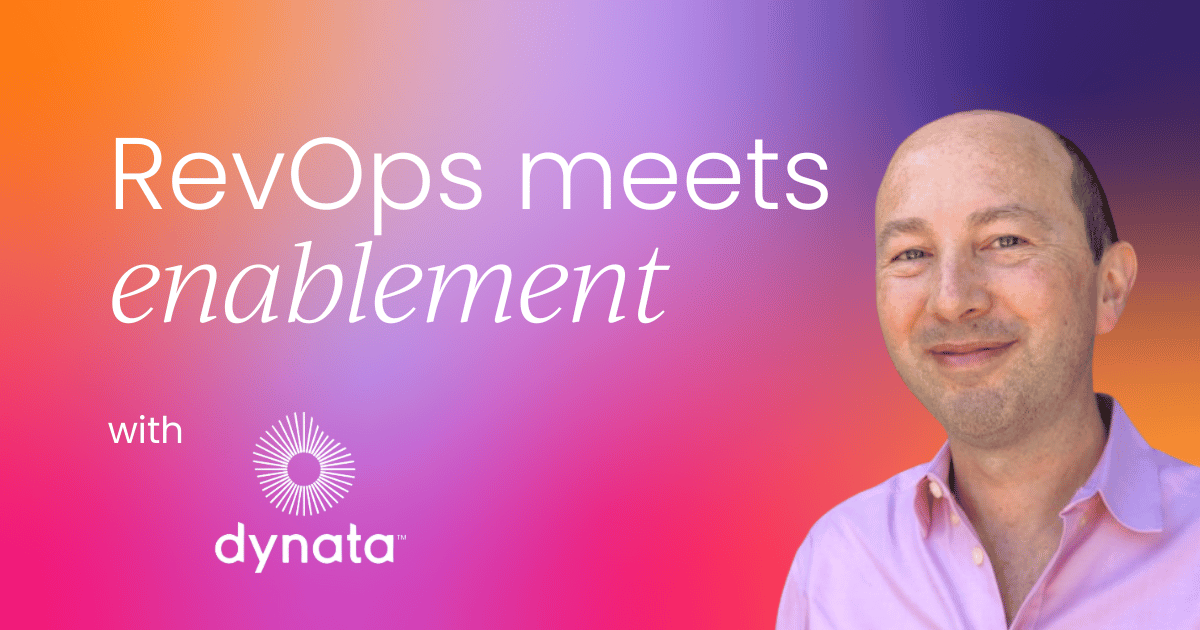I don’t know about you, but in my 15-year enablement career, I’ve seen enablement teams roll up to sales, marketing, and revenue operations. I was even on an enablement team that somehow got lumped into the customer services organization alongside consulting and support.
This confusion as to where revenue enablement sits causes more issues than it solves. In this article, I discuss why enablement should report to revenue operations and how this partnership benefits businesses.
Why enablement should report to RevOps
My current enablement team resides within the RevOps organization and here’s why I think this is the best fit…
Objectivity
RevOps is like Switzerland, objectively situated between sales and marketing to help remove silos, increase collaboration, and ultimately, drive revenue-generating productivity.
There’s no tug of war for enablement resources. We plan and project manage our work so that all GTM team needs are accounted for.

Delivery
RevOps owns the processes, platforms, and data leveraged by field teams. Whereas, enablement is often the delivery vehicle for all that goodness to land in the field.
When there’s a new product, process, or platform for the team to learn, enablement will provide the training and build a feedback loop between GTM teams and RevOps.
When RevOps has data to share, enablement will help to communicate that out to the interested parties in sales, marketing, or customer success, so those teams can make data-driven decisions.
Conversely, if there’s a data gap in the field, enablement is usually the first to hear about it and can help to prioritize new analytics and reporting within RevOps.
Adoption
RevOps can be complex and often “in the weeds” on things.
Enablement helps to remove this complexity, so GTM teams can understand the “WIIFM” (what’s in it for me) and ultimately drive adoption of new processes, programs, or platforms in the field.
Enablement teams take the time to understand and test-drive things before prime time, ensuring training hits the mark and GTM launches run smoothly and effectively.

How to create a long-term partnership
So, now that I’ve explained why I think RevOps and enablement should get married, let’s talk about how to create long-lasting alignment…
Use technology
The first step is implementing an integrated tech stack that shares data between sales, marketing, and customer success teams.
Integrated technologies remove silos at the foundation, working like a well-oiled machine to drive excellence in the field.
There’s nothing worse than piecing together data from disparate technology platforms, or coming up short on the data points you need from gaps created by unnecessary sprawl.
What happens when different teams access different versions of content or training on different platforms? Chaos in front of customers. Avoid that by letting RevOps consolidate your tech stack and enablement rally your GTM teams around it.

Break down silos
Speaking of silos, RevOps and enablement can work together to foster ongoing collaboration between operations, marketing, sales, and customer success teams.
When it comes to driving adoption around cross-functional platforms, processes, and programs, this synergy supports a unified strategy and ensures that your most important launches happen with consistency and success measurement at the forefront.
Agree on metrics
RevOps won’t let data be an afterthought.
As you’re thinking through your enablement strategies on initiatives large and small, take the time to establish agreement on core metrics, reporting cadences, stakeholder groups, and the collective goals to march toward.
It’s important to document benchmarks and what “good” looks like ahead of time so you know what you’re reaching for.
Don’t just write down the KPI buzzwords, take the time to understand up front how you’re going to measure those goals and ensure RevOps has the reporting structure in place to deliver the metrics you need.

Establish trust
Build credibility and trust between teams with frequent touchpoints and prioritization exercises to set realistic expectations for each team.
You can’t set it and forget it in business or relationships – especially if you want them to be successful. You’ve got to nurture your team, cross-functional stakeholders, business systems, and programs to ensure success and longevity.
You don’t have to boil the ocean and meet with everyone every week, but you can establish and build trust through stakeholder touchpoints on a regular cadence – whether it’s bi-weekly, monthly, or quarterly.
To give an example, I produce a quarterly RevOps and enablement metrics summary for my stakeholders, which I deliver via email and then follow up with a meeting to review and respond to any questions.
This practice ensures that none of my stakeholders are in the dark and they walk away with insights that inform their roadmaps. Teams that operate in development sprints will usually hold mid-sprint reviews as well as sprint summaries upon the conclusion of a sprint.
Let the work dictate the cadence, but never forget to keep people in the loop.
Manage change
There’s no way around it, change is hard, especially with various GTM teams and moving targets. Change management is the key to success.
It’s crucial to establish a robust internal communications strategy with your Enablement team to ensure your audience engages with changes and adopts them according to your expectations.
Leverage your RevOps team to measure your KPIs (that you agreed upon in advance, of course).

When it comes to robust change management initiatives, some organizations will have a Project Management Office (PMO) to keep track of everything and keep projects on time.
If your org doesn’t have a PMO, don’t fret, just use their playbook at the scale you need. RevOps and enablement can help with this.
One of my favorite tools to leverage for change or project management is the RACI chart – which identifies who is Responsible, Accountable, Consulted, and Informed on various components of an initiative.
In case you hadn’t noticed by this point – RevOps and enablement folks are a highly organized and process-oriented bunch.

The benefits of aligned enablement and RevOps
Of course, it wouldn’t be an article about RevOps and Enablement without the “WIIFM”.
Alignment between these two teams is going to bring your organization:
- Improved sales performance: Sales reps benefit from consistent (yet always evolving) training, coaching, and onboarding programs. You’ll see your efforts impact deal velocity, win rates, average deal size, and ramp time among other KPIs.
- Increased revenue growth: Companies with tightly aligned revenue pipelines experience faster revenue growth and higher profitability. Predictability enables companies to make informed decisions about resource allocation, investments, and overall business strategy.
- Improved customer success: A unified customer experience can turn clients into evangelists. Leverage integrated platforms, messaging, training, and communications to support your customer journey with consistency and watch your retention rates and customer advocacy increase exponentially.
Final thoughts
So, there you have it. I’ve seen firsthand why enablement and RevOps work so well together.
This harmonious relationship is paving the way for sales enablement teams to become true revenue enablement teams that drive revenue and make a substantial impact in the field.
Cheers to RevOps and enablement – may they live happily ever after!









